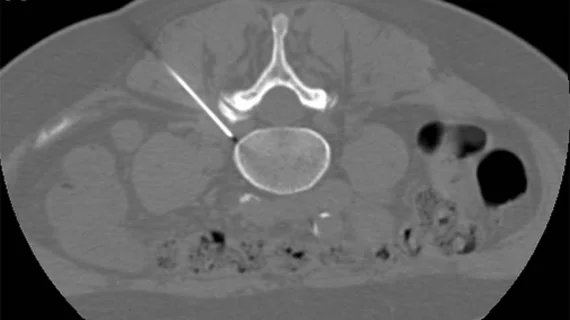Pulsed radiofrequency procedure could help patients avoid surgery for sciatica
CT-guided pulsed radiofrequency (PRF) can offer patients superior pain relief from sciatica and could potentially help many avoid the operating room.
The interventional procedure teeters somewhere in between conservative and invasive surgical treatments. In PRF procedures, a probe is used to intermittently apply energy directly to the dorsal root ganglia, which is often where pain and neurologic symptoms associated with sciatica originate.
When combined with an epidural steroid injection, PRF was recently found to significantly improve pain and reduce disabling symptoms of sciatica, according to a recent study published in Radiology.
“The goal of nonoperative care is to provide the most effective means of symptom resolution, while still avoiding the need for a surgical procedure,” said the study’s lead author, Alessandro Napoli, MD, PhD, associate professor of radiology and interventional radiology at Sapienza University of Rome in Italy. “However, in many cases conventional approaches are ineffective.”
When conservative treatments, such as anti-inflammatory medications, physical therapy, etc. fail, patients are frequently recommended to undergo transforaminal ESI (TFESI) to address their pain. However, relief from these TFESI is short lived, and patients are limited by how many injections they can receive within a certain amount of time.
In these instances, experts hypothesized that the addition of PRF could offer patients prolonged relief without them having to go under the knife for spinal surgery.
They tested their theory recently in 351 patients with sciatica. Experts divided patients into two groups—one that received a single PRF treatment in addition to TFESI and one that underwent TFESI alone—to compare patients’ pain and disability rating following treatment.
At four, 12 and 52-week follow-up visits, researchers observed significant pain reduction and improvement of disability in the PRF/TFESI group in comparison to those who underwent TFESI alone.
“The results of our trial demonstrate that a combined treatment of pulsed radiofrequency and TFESI leads to better outcomes at one year following a single 10-minute procedure,” Napoli said.
The team suggested that future research on PRF as a treatment option should include patients with motor deficits and a cost-effective analysis.
The study abstract is available here.

